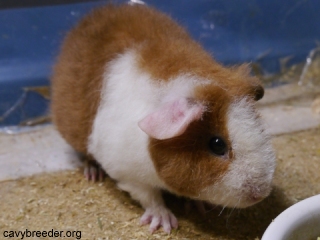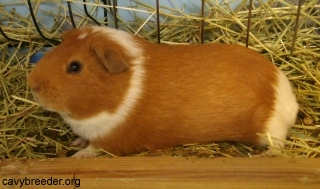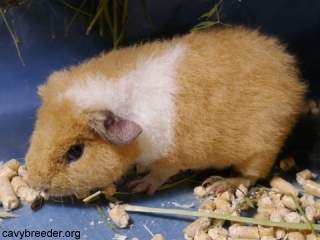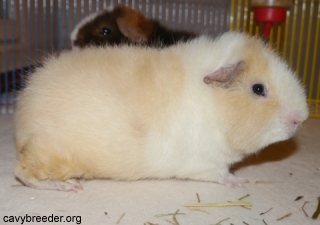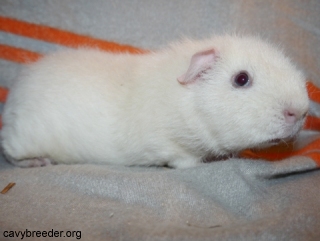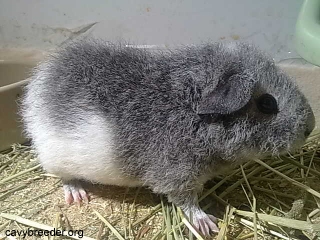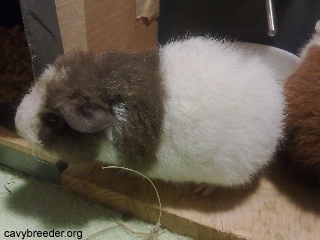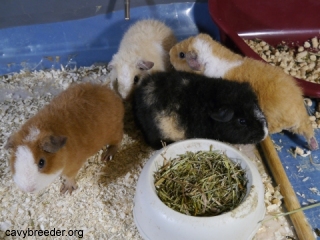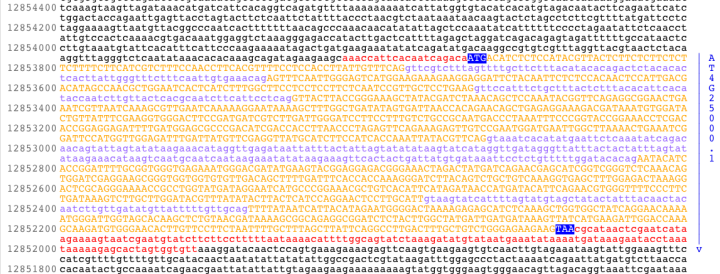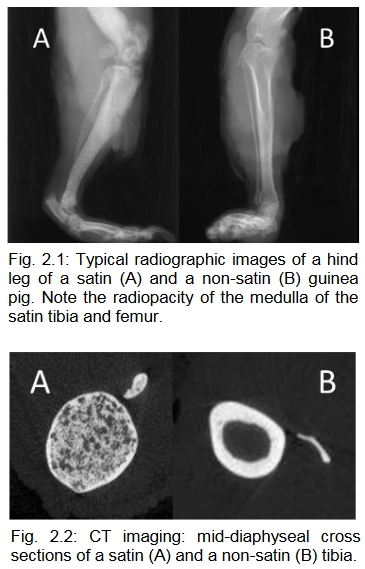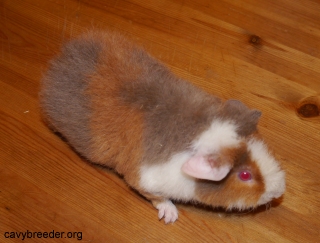Before you get your guinea pigs, it would
be wise to first:
- learn about the species (it has quirks and may not be
something you actually want to deal with);
- research what sales opportunities are realistically
available to you;
- determine if doing this is actually a good match for
your situation (and you personally).
Inbreeding is characteristic of show-type
hobbyist breeding. I recommend that as a pet breeder, you go
the opposite direction, and focus on outcrossing to the best
of your ability. The show-type, inbred animals I've owned had
health problems, worst among them for pregnant sows being
immune system problems that contribute to upper respiratory
illness. Immune system weakness can turn what's supposed to be
business assets (healthy breeding animals) into financial
liabilities (animals that get sick after getting pregnant,
which is often ruinous).
Inbred guinea pig sows are known to be a
weak links in production, producing fewer babies and smaller
babies within those litters. If there is a "win" for a pet
producer in using inbred guinea pigs (especially sows), I
don't know what it is.
Whenever I start using a guinea pig
that I know is from pedigree breeding, I treat it as a risk
factor. I set up for a long-shot outcross to something as
different as I can arrange and hope for the best.
I
recommend that you not play to low welfare
standards in guinea pig breeding - this is the
wrong species to cut welfare corners on.
In some areas, my
understanding is that the legally-mandated welfare
standards for maintaining guinea pigs are
locally-determined. Further, being classified as
rodents, the legal welfare standards for their
care may be lower in some settings than for
classical pet species (such as cats and dogs).
Some of your
competition may be rolling with lower welfare
standards than you are, and utilizing this to
boost their bottom line. Maybe your local
competition is physically located in a different
area (or even in a different country) and they
ship to your local pet stores. Maybe your
competition is getting away with something they
shouldn't be. Who knows.
If you're competing with
someone who is more efficient expense-wise for
some reason, you need as much of an edge as you
can get.
Inbred breeding stock
with an inclination toward genetic disease would
be the opposite of an edge.
Utilizing outcrossed
breeding stock can be one part of minimizing your
expenses and losses, regardless of what your
competition may be doing differently, or what
business advantages they might have.
|
It is likely that you will be getting young
sows that you will be starting in their first pregnancies.
These sows should weigh between 500 and 600 grams when they
are mated by the boar for the first time. Sows will generally
be between 2.5 and 3 months old when they attain this weight.
Although I usually cannot personally
arrange this, I think the ideal arrangement for first-time
young sows might be to have them be mated by a boar that is
their same age. A young boar's sperm count is lower than older
boars in their breeding prime, and maybe this would effect
fewer babies in that first litter. A sow's first litter having
fewer babies is in my experience ideal for various reasons
(such as smaller litters being less stress on the sow and
considering the young sow's more limited milk supply). If you
can't arrange this and will be using an older boar, don't
worry about it, its pretty common to do that.
Sows are sexually fertile for a while
before they reach 500 - 600 grams, so beware of a
sexually-mature boar being in with sows that are smaller than
this.
If for some reason your young sows are not
mated on time and you still want to use them, try to ensure
that they deliver their first litter before or at their
6-month birthday at the latest (so, mated by the boar
something like a week before their 4-month birthday). It's not
a guaranteed catastrophe if they are bred late, but there is a
risk. It is possible that a late-bred sow's pelvis may not
open up at birthing time (it can fuse closed with increasing
age in this species). If a sow's pelvis is fused and there's
babies inside of her, its either a euthanasia or an emergency
trip to an exotic veterinary surgeon for a c-section (and if
you go that route, hopefully you get a mother that feels
good enough to nurse after that, which is not guaranteed).
Instead of getting young, first-time sows,
it would theoretically be possible to use sows that have
already had at least one litter. But in practice you won't
tend to have access to this. I think it's because sows' usable
breeding lifespans don't tend to work out this way.
Boars become sexually mature a bit later
than sows. Puberty for boars is considered to be on average at
18 weeks, but there could be individual variability, as sperm
motility may be seen as early as 11 weeks.
Do
not house intended breeding boars on wood
shavings. Some boars housed this way will become
infertile because of the wood shavings causing
issues with their male
parts.
|
In terms of mature but virgin /
inexperienced boars: I have had success with boars that are 1
year old virgins, but if I have a choice for a first-time sow,
for timing reasons I prefer an experienced boar or a young one
(which will have a lot of drive).
It is possible for boars to have sexual
performance problems. Especially with first-time sows, you
want to be sure you're using a boar that does not have this
kind of issue.
Some issues that boars can have are:
- Boar is young, small, and inexperienced
- (these do get it right eventually and they have a lot
of energy; my concern is getting it done on time if time
is tight).
- Boar is old:
- difficulty standing tall enough to mount sows,
- cannot chase them well,
- cannot get it up any more, which is dangerous for the
boar's health because his male part could come out but
not do much other than hang there, and he would drag it
on the cage floor while chasing a sow and injure it.
- Boar was a virgin for too long or not sexually active
enough, doesn't seem to know how to get the job done.
- keeps doing it wrong, like mounting the sow's head or
shoulders
- climbs up too far over her back
- may dump his load on the cage floor next to the sow
It's much easier to find boars for sale
which have breeding experience than sows that have been bred.
I've gotten a number of these off of the local equivalent of
Craigslist. 2 of them were the kind of outcrosses I like, and
one of those was a homogeneous dark-eyed white (which was very
nice to have). Most of them were a genetic sense good quality.
When you are getting the first guinea pigs,
you won't necessarily have much choice about which animals you
get. The sources of guinea pigs available in one area are not
always numerous.
Once you are established, you generally use
more sows than boars. One strategy to maintain genetic
diversity is to use sows that you breed yourself and bring in
new, unrelated boars to cover them.
Chirodiscoides caviae
"Cavy Mites"
"Fur Mites"
Assume all newly-aquired
guinea pig have this.
You should not let your guinea pigs be infested
with this.
It is easy to remove when done correctly.
-------------
A sign of this is, guinea pigs using their teeth
to
chew their skin in the area of their rear legs.
--------------
After giving birth, some sows may scratch/bite
themselves,
maybe making large, open wounds.
Guinea pigs that are stressed/sick or in warmer
temperature cages
can begin scratching and making thin fur spots.
My teddies in particular do not do well with this
parasite, but
there could be other coat types that have
increased sensitivity.
If you sent babies out for sale with this,
they might start scratching and having symptoms.
------------
Protocol to remove and keep it out:
Revolution/Stronghold (selamectin)
topical medication.
It's prescription-only, do what you have to do.
Using the dog formulation (12% w/v solution):
Applied to the skin on the back of the neck:
0.1 ml (1/10th of a ml) per kilogram of
body weight,
(or on smaller guinea pigs, 0.01 per 100 grams of
body weight,
these are the very tiny lines on a 1ml syringe).
(This dosage is to the large side
because of this parasite's resistance and long
life cycle.)
You do not have to treat the cage or environment.
Wait 2 weeks.
Repeat the treatment one more time.
Safe to assume no longer transmissible within the
week after dose #2.
As far as I can see, safe for all ages / any
reproductive status.
-----
To keep it out, treat ones you have which have not
yet been done,
isolate new ones 2-3wk while treating with the 2
doses.
Don't waste time or money testing for it
(it's prone to false negatives anyway)
|
Ringworm
If something has this, it will be in localized
area(s) on the skin.
You may be able to see where it is forming
ring-like shapes.
Carefully check anything new you are bringing
in.
Localized sores or scabby areas could be
ringworm.
The best treatment I know for this is topical
enilconazole
(trade name Imaverol Vet)
(1ml of Imaverol Vet is mixed into 50ml of
water)
As of 2024,
Imaverol is available world-wide except for in
the United States
which is inappropriately blocking it.
It's illegal to ship this into USA.
I've heard you will get big fines if you try to
ship it in.
I've used other topical antifungals to remove
ringworm such as
ketoconazole shampoo (Nizoral and cheaper
generic equivalents)
and non-prescription "Azole" antifungal creams.
Its highly contagious and can persist in the
environment.
Hopefully, you don't get a big problem with
this.
People can catch this,
kids seem more susceptible than adults.
|
Pregnancy Toxemia
There is a catastrophic
condition called pregnancy toxemia. The
fetuses die quickly, plus you frequently
lose the sow (in spite of rehabilitation
efforts).
The short reason it happens is, the guinea
pig's intestine is not processing any food.
To my knowledge the cause of this can be:
- the sow stopped eating, for any
reason,
- food cannot move through the digestive
tract for some reason,
- part of the digestive tract died (such
as the intestines) which is of course
irreversible.
- To my knowledge this can happen
because some mechanical situation
caused compression of important blood
vessels in the gut:
- overhandling
- incorrect handling
- fetus weight and position
Handling
of late pregnancy sows is to be
minimized!
|
